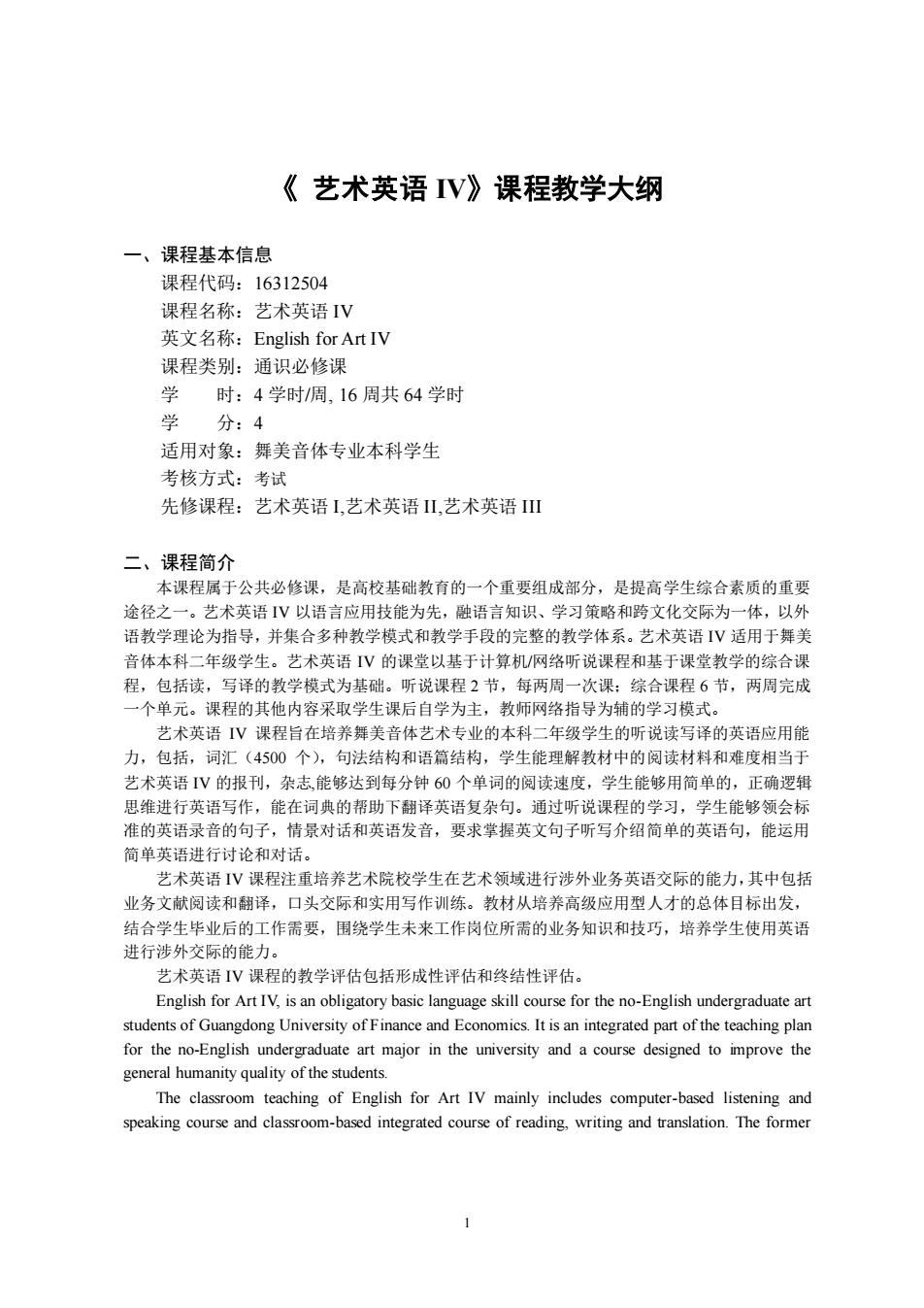
《艺术英语V》课程教学大纲 一、课程基本信息 课程代码:16312504 课程名称:艺术英语IV 英文名称:English for Art IV 课程类别:通识必修课 时:4学时/周,16周共64学时 学 分分:4 适用对象:舞美音体专业本科学生 考核方式:考试 先修课程:艺术英语,艺术英语,艺术英语山 二、课程简介 本课程属于公共必修课,是高校基础教有的一个重要组成部分,是提高学生综合素质的重婴 途径之一。艺术英语V以语言应用技能为先,融语言知识、学习策略和跨文化交际为一体,以外 语教学理论为指导,并集合多种教学模式和教学手段的完整的教学体系。艺术英语V适用于舞美 音体本科二年级学生。 艺术英语IV的课堂以基于计算机网络听说课程和基于课堂教学的综合课 程,包括读,写译的教学模式为基础 。听说课程2节,每两周 一次课:综合课程6节,两周完成 :个单元。课程的其他内容采取学生课后自学为主,教师网络指导为辅的学习模式。 艺术英语IV课程旨在培养舞美音体艺术专业的本科二年级学生的听说读写译的英语应用能 力,包括,词汇(4500个),句法结构和语篇结构,学生能理解教材中的阅读材料和难度相当于 艺术英语V的报刊,杂志,能够达到每分钟60个单词的阅读速度,学生能够用简单的,正确逻 思维进行英语写作,能在词典的帮助下翻译英语复杂句。通过听说课程的学习 学生能够领会标 准的英语录音的句子,情景对话和英语发音,要求掌握英文句子听写介绍简单的英语句,能运用 简单英语进行讨论和对话。 艺术英语IV课程注重培养艺术院校学生在艺术领域进行涉外业务英语交际的能力,其中包括 业务文献阅诗和翻怪,口头交际和实用写作加练。教材从培养高级应用型人木的总体目标出发, 结合学生毕业后的工作需要,围绕学生未来工作岗位所需的业务知识和技巧,培养学生使用英语 进行涉外交际的能力。 艺术英语V课程的教学评估包括形成性评估和终结性评估。 English for Art IV.is an obligatory basic language skill course for the no-English undergraduate art students of Guangdong University of Finance and Economics It is an integrated par of the teaching plan for the no-English art major in the university and a course designed to improve general humanity quaity of the students The classroom teaching of English for Art IV mainly includes computer-based listening and speaking course and classroom-based integrated course of reading,writing and translation.The former 1
1 《 艺术英语 IV》课程教学大纲 一、课程基本信息 课程代码:16312504 课程名称:艺术英语 IV 英文名称:English for Art IV 课程类别:通识必修课 学 时:4 学时/周, 16 周共 64 学时 学 分:4 适用对象:舞美音体专业本科学生 考核方式:考试 先修课程:艺术英语 I,艺术英语 II,艺术英语 III 二、课程简介 本课程属于公共必修课,是高校基础教育的一个重要组成部分,是提高学生综合素质的重要 途径之一。艺术英语 IV 以语言应用技能为先,融语言知识、学习策略和跨文化交际为一体,以外 语教学理论为指导,并集合多种教学模式和教学手段的完整的教学体系。艺术英语 IV 适用于舞美 音体本科二年级学生。艺术英语 IV 的课堂以基于计算机/网络听说课程和基于课堂教学的综合课 程,包括读,写译的教学模式为基础。听说课程 2 节,每两周一次课;综合课程 6 节,两周完成 一个单元。课程的其他内容采取学生课后自学为主,教师网络指导为辅的学习模式。 艺术英语 IV 课程旨在培养舞美音体艺术专业的本科二年级学生的听说读写译的英语应用能 力,包括,词汇(4500 个),句法结构和语篇结构,学生能理解教材中的阅读材料和难度相当于 艺术英语 IV 的报刊,杂志,能够达到每分钟 60 个单词的阅读速度,学生能够用简单的,正确逻辑 思维进行英语写作,能在词典的帮助下翻译英语复杂句。通过听说课程的学习,学生能够领会标 准的英语录音的句子,情景对话和英语发音,要求掌握英文句子听写介绍简单的英语句,能运用 简单英语进行讨论和对话。 艺术英语 IV 课程注重培养艺术院校学生在艺术领域进行涉外业务英语交际的能力,其中包括 业务文献阅读和翻译,口头交际和实用写作训练。教材从培养高级应用型人才的总体目标出发, 结合学生毕业后的工作需要,围绕学生未来工作岗位所需的业务知识和技巧,培养学生使用英语 进行涉外交际的能力。 艺术英语 IV 课程的教学评估包括形成性评估和终结性评估。 English for Art IV, is an obligatory basic language skill course for the no-English undergraduate art students of Guangdong University of Finance and Economics. It is an integrated part of the teaching plan for the no-English undergraduate art major in the university and a course designed to improve the general humanity quality of the students. The classroom teaching of English for Art IV mainly includes computer-based listening and speaking course and classroom-based integrated course of reading, writing and translation. The former
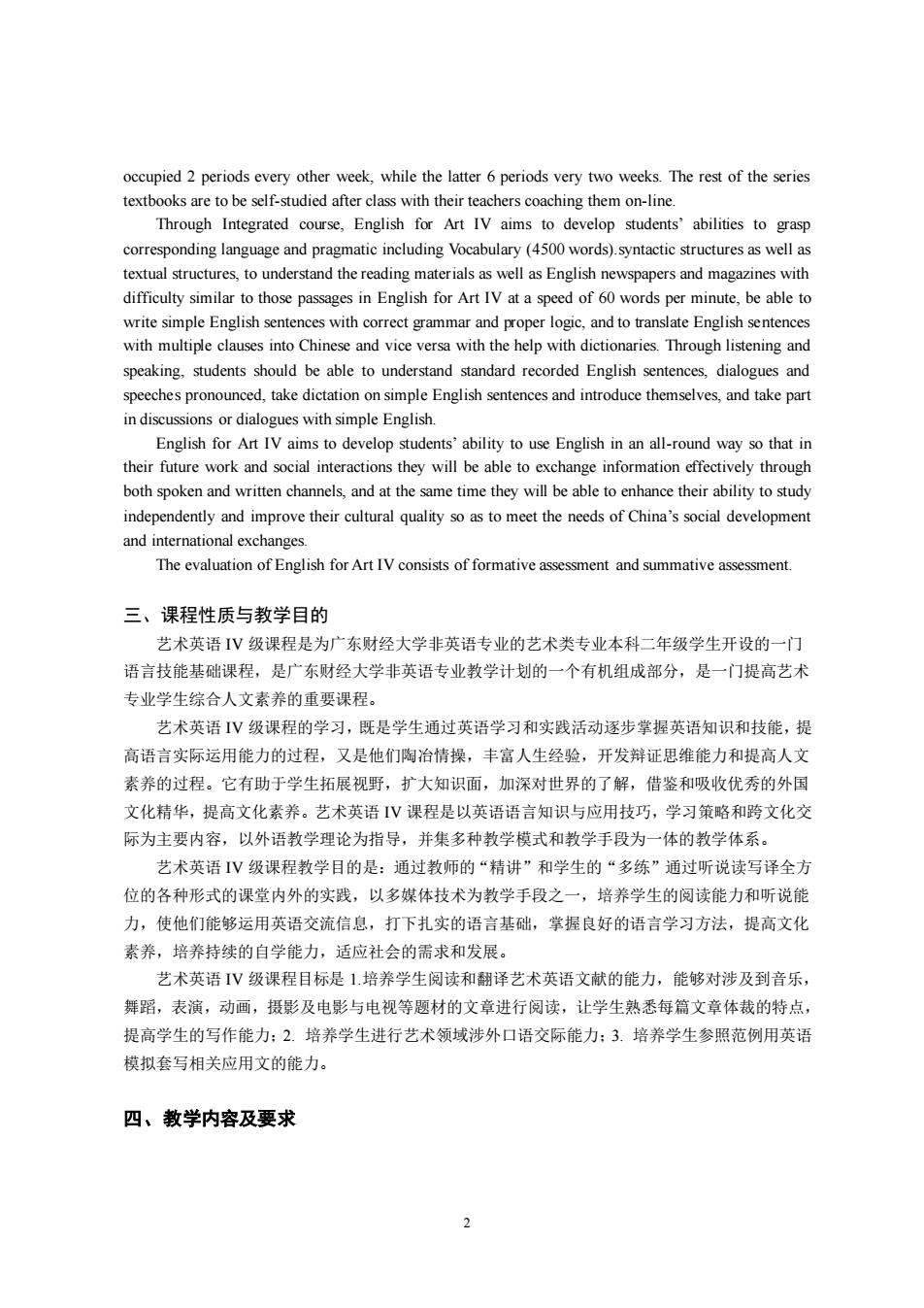
occupied 2 periods every other week,while the latter 6 periods very two weeks.The rest of the series textbooks are to be self-studied after class with their teachers coaching them on-line. Through Integrated course.English for Art Iv aims to develop students'abilities to grasp language and pragmatic including Vocabulary ()as well as textual to understand the reading materialsas well as English newspapers and magazines with difficulty similar to those passages in English for Art IV at a speed of 60 words per minute,be able to write simple English sentences with correct grammar and proper logic,and to translate English sentences with multiple clauses into Chinese and vice versa with the help with dictionaries Through listening and speaking.students should be able to understand standard recorded English dialogues and speeches pronounced,take dictationonsimp English inr ce themselves,and take par in discussions or dialogues with simple English. English for Art IV aims to develop students'ability to use English in an all-round way so that in their future work and social interactions they will be able to exchange information effectively through both spoken and written channels,and at the same time they will be able to enhance their ability to study and international exchanges. The evaluation of English for Art IV consists of formative assessment and summative assessment. 三、课程性质与教学目的 艺术英语V级课程是为广东财经大学非英语专业的艺术类专业本科二年级学生开设的一门 语言技能基础课程,是广东财经大学非英语专业教学计划的一个有机组成部分,是一门提高艺术 专业学生综合人文素养的重要课程。 艺术英语V级课程的学习,既是学生通过英语学习和实践活动逐步掌握英语知识和技能,提 高语言实际运用能力的过程,又是他们陶治情操,丰富人生经验,开发辩证思维能力和提高人文 素养的过程。它有助于学生拓展视野,扩大知识面,加深对世界的了解,借鉴和吸收优秀的外国 文化精华,提高文化素养。艺术英语V课程是以英语语言知识与应用技巧,学习策略和跨文化交 际为主要内容,以外语教学理论为指导,并集多种教学模式和教学手段为一体的教学体系。 艺术英语V级课程教学目的是:通过教师的“精讲”和学生的“多练”通过听说读写译全方 位的各种形式的课堂内外的实践,以多媒体技术为教学手段之一,培养学生的阅读能力和听说能 力,使他们能够运用英语交流信总,打下扎实的语言基础,掌握良好的语言学习方法,提高文化 素养,培养持续的自学能力,适应社会的需求和发展。 艺术英语V级课程目标是1培养学生阅读和翻译艺术英语文献的能力,能够对涉及到音乐】 舞蹈,表演,动画,摄影及电影与电视等题材的文章进行阅读,让学生熟悉每篇文章体裁的特点, 提高学生的写作能力:2.培养学生进行艺术领域涉外口语交际能力:3.培养学生参照范例用英语 模拟套写相关应用文的能力。 四、教学内容及要求 2
2 occupied 2 periods every other week, while the latter 6 periods very two weeks. The rest of the series textbooks are to be self-studied after class with their teachers coaching them on-line. Through Integrated course, English for Art IV aims to develop students’ abilities to grasp corresponding language and pragmatic including Vocabulary (4500 words).syntactic structures as well as textual structures, to understand the reading materials as well as English newspapers and magazines with difficulty similar to those passages in English for Art IV at a speed of 60 words per minute, be able to write simple English sentences with correct grammar and proper logic, and to translate English sentences with multiple clauses into Chinese and vice versa with the help with dictionaries. Through listening and speaking, students should be able to understand standard recorded English sentences, dialogues and speeches pronounced, take dictation on simple English sentences and introduce themselves, and take part in discussions or dialogues with simple English. English for Art IV aims to develop students’ ability to use English in an all-round way so that in their future work and social interactions they will be able to exchange information effectively through both spoken and written channels, and at the same time they will be able to enhance their ability to study independently and improve their cultural quality so as to meet the needs of China’s social development and international exchanges. The evaluation of English for Art IV consists of formative assessment and summative assessment. 三、课程性质与教学目的 艺术英语 IV 级课程是为广东财经大学非英语专业的艺术类专业本科二年级学生开设的一门 语言技能基础课程,是广东财经大学非英语专业教学计划的一个有机组成部分,是一门提高艺术 专业学生综合人文素养的重要课程。 艺术英语 IV 级课程的学习,既是学生通过英语学习和实践活动逐步掌握英语知识和技能,提 高语言实际运用能力的过程,又是他们陶冶情操,丰富人生经验,开发辩证思维能力和提高人文 素养的过程。它有助于学生拓展视野,扩大知识面,加深对世界的了解,借鉴和吸收优秀的外国 文化精华,提高文化素养。艺术英语 IV 课程是以英语语言知识与应用技巧,学习策略和跨文化交 际为主要内容,以外语教学理论为指导,并集多种教学模式和教学手段为一体的教学体系。 艺术英语 IV 级课程教学目的是:通过教师的“精讲”和学生的“多练”通过听说读写译全方 位的各种形式的课堂内外的实践,以多媒体技术为教学手段之一,培养学生的阅读能力和听说能 力,使他们能够运用英语交流信息,打下扎实的语言基础,掌握良好的语言学习方法,提高文化 素养,培养持续的自学能力,适应社会的需求和发展。 艺术英语 IV 级课程目标是 1.培养学生阅读和翻译艺术英语文献的能力,能够对涉及到音乐, 舞蹈,表演,动画,摄影及电影与电视等题材的文章进行阅读,让学生熟悉每篇文章体裁的特点, 提高学生的写作能力;2. 培养学生进行艺术领域涉外口语交际能力;3. 培养学生参照范例用英语 模拟套写相关应用文的能力。 四、教学内容及要求
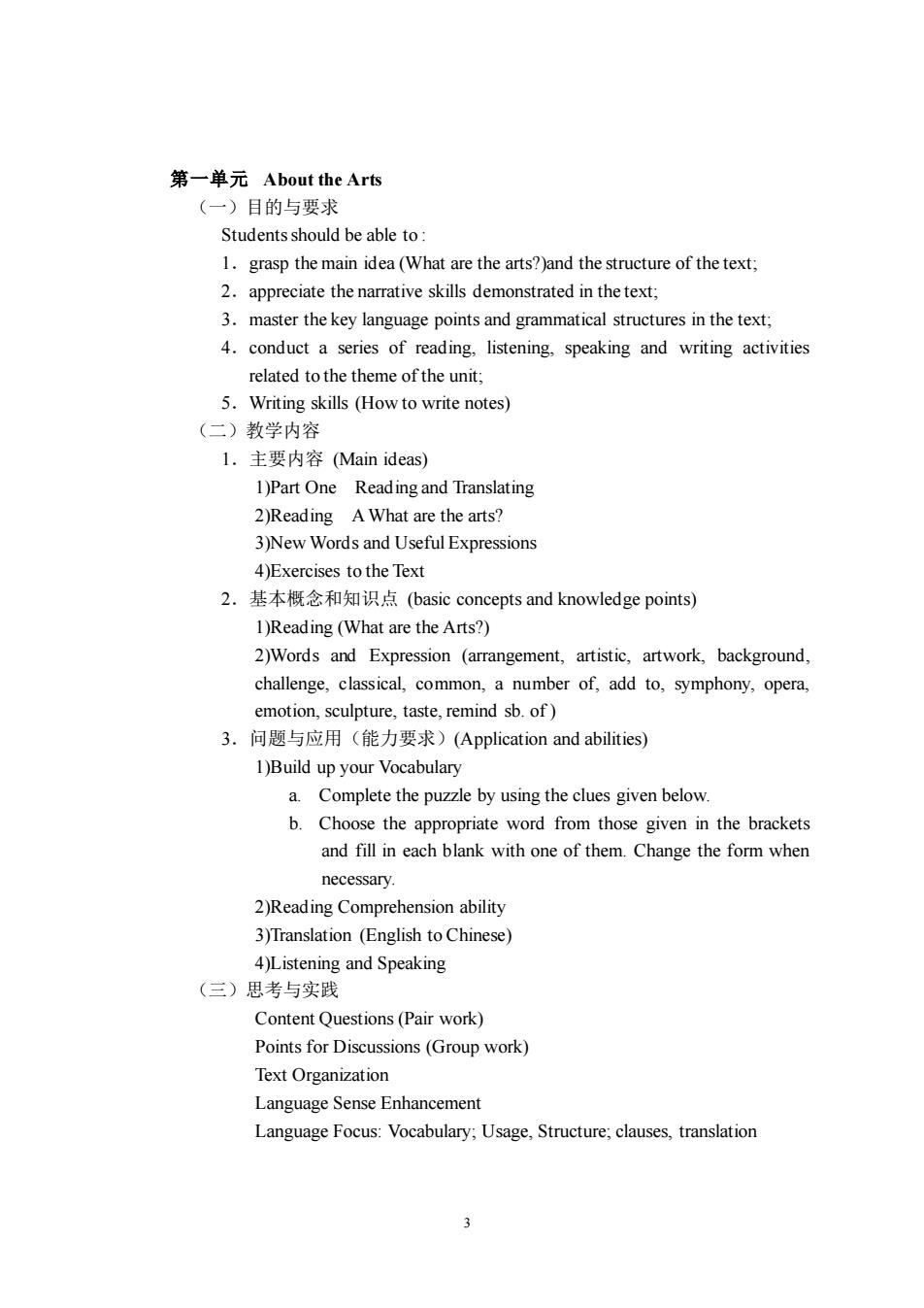
第一单元About the Arts (一)目的与要求 Students should be able to: 1.grasp the main idea(What are the arts?)and the structure of the text. 2.appreciate the narrative skills demonstrated in the text; 3.master the key language points and grammatical structures in the text; 4.conduct a series of reading.listening.speaking and writing activities related to the theme of the unit; 5.Writing skills (How to write notes) (二)教学内容 1.主要内容Main ideas)) 1)Part One Reading and Translating 2)Reading A What are the arts? 3)New Words and Useful Expressions 4)Exercises to the Text 2.基本概念和知识点(basic concepts and knowledge points) 1)Reading(What are the Arts?) 2)Words and Expression (arrangement,artistic,artwork,background, challenge,classical,common,a number of,add to,symphony,opera emotion,sculpture,taste,remind sb.of) 3.问题与应用(能力要求)(Application and abilities 1)Build up your Vocabulary a.Complete the puzzle by using the clues given below b.Choose the appropriate word from those given in the brackets and fill in each blank with one of them.Change the form when necessary 2)Reading Comprehension ability 3)Translation (English to Chinese) 4)Listening and Speaking (三)思考与实践 Content Questions(Pair work) Points for Discussions(Group work) Text Organization Language Sense Enhancement Language Focus:Vocabulary;Usage,Structure;clauses,translation 3
3 第一单元 About the Arts (一)目的与要求 Students should be able to : 1.grasp the main idea (What are the arts?)and the structure of the text; 2.appreciate the narrative skills demonstrated in the text; 3.master the key language points and grammatical structures in the text; 4.conduct a series of reading, listening, speaking and writing activities related to the theme of the unit; 5.Writing skills (How to write notes) (二)教学内容 1.主要内容 (Main ideas) 1)Part One Reading and Translating 2)Reading A What are the arts? 3)New Words and Useful Expressions 4)Exercises to the Text 2.基本概念和知识点 (basic concepts and knowledge points) 1)Reading (What are the Arts?) 2)Words and Expression (arrangement, artistic, artwork, background, challenge, classical, common, a number of, add to, symphony, opera, emotion, sculpture, taste, remind sb. of ) 3.问题与应用(能力要求)(Application and abilities) 1)Build up your Vocabulary a. Complete the puzzle by using the clues given below. b. Choose the appropriate word from those given in the brackets and fill in each blank with one of them. Change the form when necessary. 2)Reading Comprehension ability 3)Translation (English to Chinese) 4)Listening and Speaking (三)思考与实践 Content Questions (Pair work) Points for Discussions (Group work) Text Organization Language Sense Enhancement Language Focus: Vocabulary; Usage, Structure; clauses, translation

Home Reading(Text B)and Exercises Self-assessment listening Listening and Speaking:Home Listening,Speaking Tasks,Pair work (四)教学方法与手段 课堂讲授,课堂讨论,多媒体,网络学习,自主学习 第二单元Music (一)目的与要求 Students should be able to: 1.grasp the main idea (How a piano Works?)and the structure of the text, 2.appreciate the narrative skills demonstrated in the text; 3 master the key language points and grammatical structures in the text 4.conduct a series of reading.listening,speaking and writing activities related to the theme of the unit; 5.Writing skill (Small Ad) (二)教学内容 1.主要内容Main ideas) 1)Part One Reading and Translation 2)Passage A How a Piano Works 3)Part two Listing and Speaking 4)Part Three Real Life Writing 5)Exercises to The Text 6)Music has no boundary.We love music.We love the peaceful world. 2.基本概念和知识点(basic concepts and knowledge points) 1)Reading (How a Piano Works?Music in Our Lives) 2)Words and Expression (board,arrange,damper,depend,hammer, instrument,lever,melody,note,pedal,pitch,press,tune,vibrate,depend on, different/all kinds of/make use of) 3.问题与应用(能力要求)(Application and abilities) 1)Language grasp:Match the name with the part of a piano by writing the corresponding numbers in front of the words listed below. 2)Choose the appropriate word from the brackets.Change the form when necessary (damper,soft,string,pedal,hammer,loud) 4
4 Home Reading ( Text B) and Exercises Self-assessment listening Listening and Speaking: Home Listening, Speaking Tasks, Pair work (四)教学方法与手段 课堂讲授,课堂讨论,多媒体,网络学习,自主学习 第二单元 Music (一)目的与要求 Students should be able to : 1. grasp the main idea (How a piano Works?) and the structure of the text; 2. appreciate the narrative skills demonstrated in the text; 3. master the key language points and grammatical structures in the text; 4. conduct a series of reading, listening, speaking and writing activities related to the theme of the unit; 5. Writing skill ( Small Ad) (二)教学内容 1.主要内容 (Main ideas) 1) Part One Reading and Translation 2) Passage A How a Piano Works 3) Part two Listing and Speaking 4) Part Three Real Life Writing 5) Exercises to The Text 6) Music has no boundary. We love music. We love the peaceful world. 2.基本概念和知识点 (basic concepts and knowledge points) 1) Reading (How a Piano Works? Music in Our Lives) 2) Words and Expression (board, arrange, damper, depend, hammer, instrument, lever, melody, note, pedal, pitch, press, tune, vibrate, depend on, different/all kinds of / make use of ) 3.问题与应用(能力要求)(Application and abilities) 1) Language grasp: Match the name with the part of a piano by writing the corresponding numbers in front of the words listed below. 2) Choose the appropriate word from the brackets. Change the form when necessary (damper, soft, string, pedal, hammer, loud)
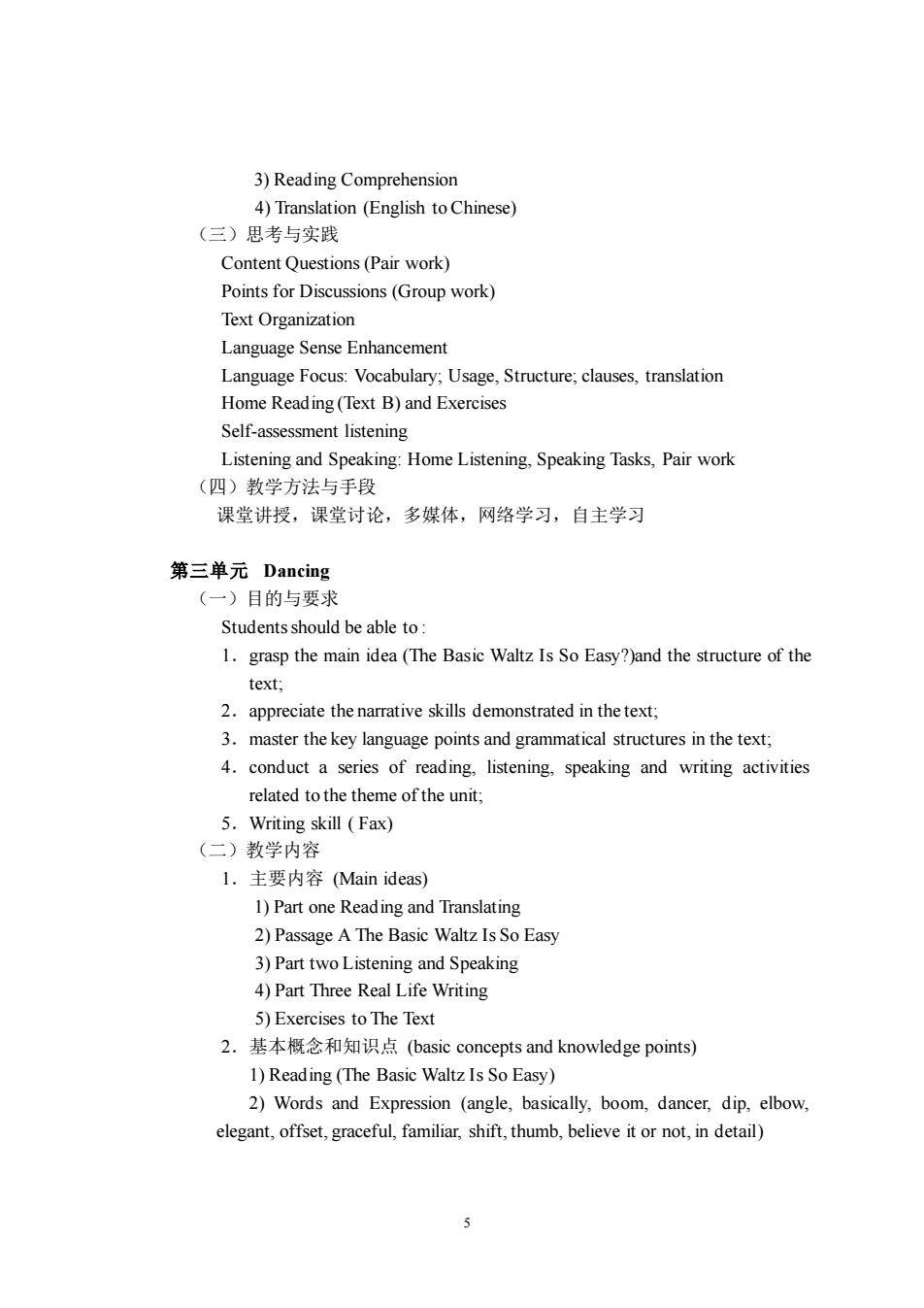
3)Reading Comprehension 4)Translation(English to Chinese) (三)思考与实践 Content Questions(Pair work) Points for Discussions (Group work) Text Organization Language Sense Enhancement Language Focus:Vocabulary;Usage,Structure;clauses,translation Home reading (Text b)and exercises Self-assessment listening Listening and Speaking:Home Listening.Speaking Tasks,Pair work (四)教学方法与手段 课堂讲授,课堂讨论,多媒体,网络学习,自主学习 第三单元Dancing (一)目的与要求 Students should be able to 1.grasp the main idea(The Basic Waltz Is So Easy?and the structure of the text: 2.appreciate the narrative skills demonstrated in the text; 3.master the key language points and grammatical structures in the text: 4.conduct a series of reading,listening,speaking and writing activities related to the theme of the unit 5.Writing skill Fax) (二)教学内容 1.主要内容(Main ideas)) 1)Part one Reading and Translating 2)Passage A The Basic Waltz Is So Easy 3)Part two Listening and Speaking 4)Part Three Real Life Writing 5)Exercises to The Text 2.基本概念和知识点(basic concepts and knowledge points) 1)Reading (The Basic Waltz Is So Easy) 2)Words and Expression (angle,basically,boom,dancer,dip,elbow elegant,offset,graceful,familiar,shift,thumb,believe it or not,in detail) 5
5 3) Reading Comprehension 4) Translation (English to Chinese) (三)思考与实践 Content Questions (Pair work) Points for Discussions (Group work) Text Organization Language Sense Enhancement Language Focus: Vocabulary; Usage, Structure; clauses, translation Home Reading (Text B) and Exercises Self-assessment listening Listening and Speaking: Home Listening, Speaking Tasks, Pair work (四)教学方法与手段 课堂讲授,课堂讨论,多媒体,网络学习,自主学习 第三单元 Dancing (一)目的与要求 Students should be able to : 1.grasp the main idea (The Basic Waltz Is So Easy?)and the structure of the text; 2.appreciate the narrative skills demonstrated in the text; 3.master the key language points and grammatical structures in the text; 4.conduct a series of reading, listening, speaking and writing activities related to the theme of the unit; 5.Writing skill ( Fax) (二)教学内容 1.主要内容 (Main ideas) 1) Part one Reading and Translating 2) Passage A The Basic Waltz Is So Easy 3) Part two Listening and Speaking 4) Part Three Real Life Writing 5) Exercises to The Text 2.基本概念和知识点 (basic concepts and knowledge points) 1) Reading (The Basic Waltz Is So Easy) 2) Words and Expression (angle, basically, boom, dancer, dip, elbow, elegant, offset, graceful, familiar, shift, thumb, believe it or not, in detail)

3)Reading Comprehension 4)Translation(English to Chinese) 3.问题与应用(能力要求)(Application and abilties) 1)Language grasp:Match the name with the part of a piano by writing the corresponding numbers in front of the words listed below. 2)Choose the appropriate word from the brackets.Change the form when necessary romantic,backwards,waltz,partner,step) 3)Reading Comprehension 4)Translation(English to Chinese) (三)思考与实践 Content Questions(Pair work) Points for Discussions(Group work) Text Organization Language Sense Enhancement Language Focus:Vocabulary,Usage,Structure.clauses,translatior Home Reading(Text B)and Exercises Self-assessment listening Listening and Speaking:Home Listening,Speaking Tasks,Pair work (四)教学方法与手段 课堂讲授,课堂讨论,多媒体,网络学习,自主学习 第四单元Fine Arts (一)目的与要求 Students should be able to: 1.grasp the main idea(Stages ofChild Art)and the structure of the text: 2.appreciate the narrative skills demonstrated in the text; 3.master the key language points and grammatical structures in the text; 4.conduct a series of reading.listening.speaking and writing activities related tothe theme of the unit; 5.Writing Skills Note) (二)教学内容 L.主要内容(Main ideas) 1)Part one Reading and Translating 2)Passage A The Basic Waltz IsSo Easy 3)Part two Listing and Speaking 6
6 3) Reading Comprehension . 4) Translation (English to Chinese) 3.问题与应用(能力要求)(Application and abilities) 1) Language grasp: Match the name with the part of a piano by writing the corresponding numbers in front of the words listed below. 2) Choose the appropriate word from the brackets. Change the form when necessary ( romantic, backwards, waltz, partner, step) 3) Reading Comprehension . 4) Translation (English to Chinese) (三)思考与实践 Content Questions (Pair work) Points for Discussions ( Group work) Text Organization Language Sense Enhancement Language Focus: Vocabulary; Usage, Structure; clauses, translation Home Reading ( Text B) and Exercises Self-assessment listening Listening and Speaking: Home Listening, Speaking Tasks, Pair work (四)教学方法与手段 课堂讲授,课堂讨论,多媒体,网络学习,自主学习 第四单元 Fine Arts (一)目的与要求 Students should be able to : 1.grasp the main idea (Stages of Child Art) and the structure of the text; 2.appreciate the narrative skills demonstrated in the text; 3.master the key language points and grammatical structures in the text; 4.conduct a series of reading, listening, speaking and writing activities related to the theme of the unit; 5.Writing Skills ( Note) (二)教学内容 1.主要内容 (Main ideas) 1)Part one Reading and Translating 2)Passage A The Basic Waltz Is So Easy 3)Part two Listing and Speaking
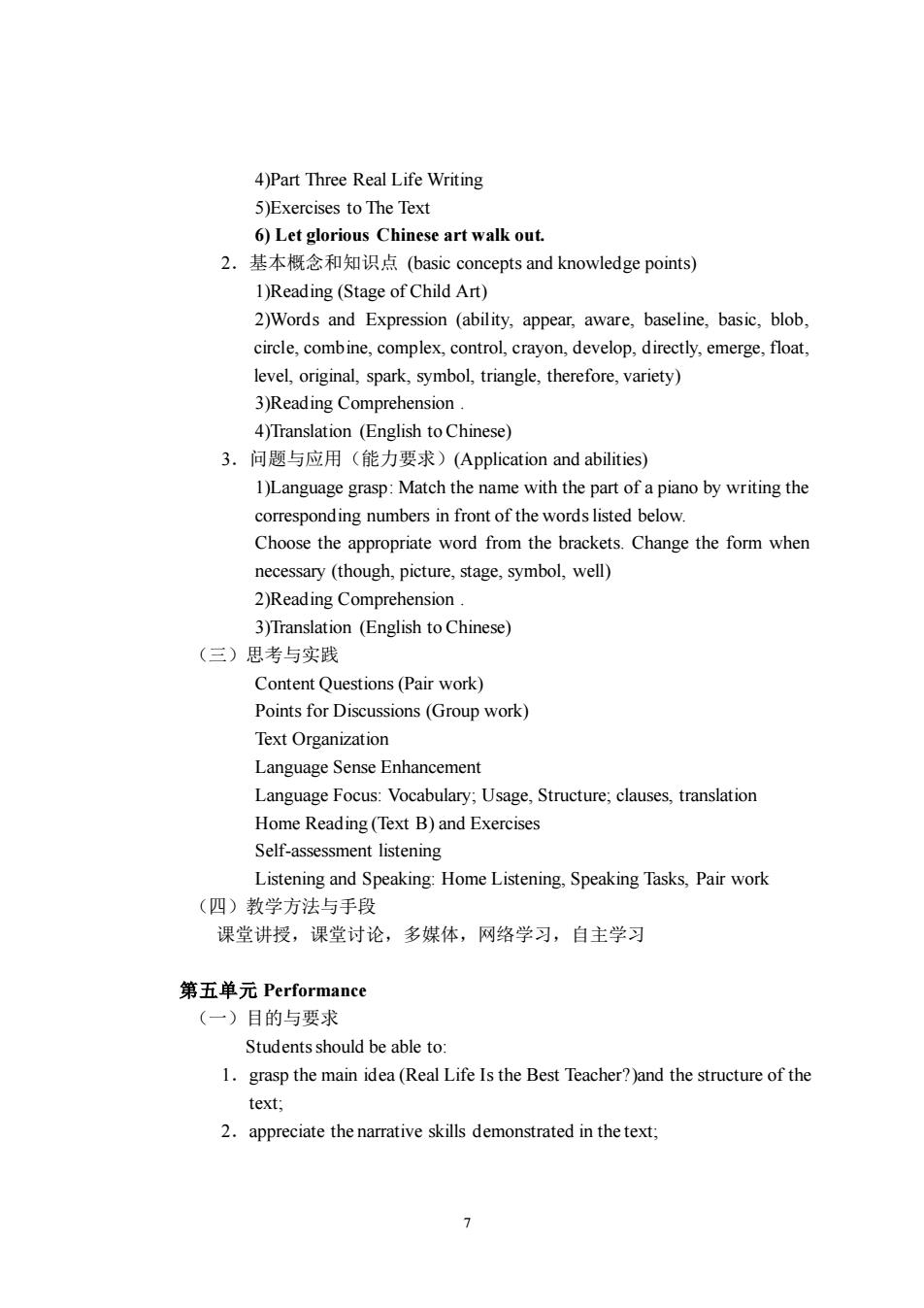
4)Part Three Real Life Writing 5)Exercises to The Text 6)Let glorious Chinese art walk out. 2.基本概念和知识点(basic concepts and knowledge points) 1)Reading(Stage of Child Art) 2)Words and Expression (ability,appear,aware,baseline,basic,blob circle.combine,complex,control,crayon,develop.directly,emerge.float, level,original,spark,symbol,triangle,therefore,variety) 3)Reading Comprehension 4)Translation(English to Chinese) 3.问题与应用(能力要求)(Application and abilities) 1)Language grasp:Match the name with the part of a piano by writing the corresponding numbers in front of the words listed below Choose the appropriate word from the brackets.Change the form when necessary(though,picture,stage,symbol,well) 2)Reading Comprehension 3)Translation (English to Chinese) (三)思考与实践 Content Questions(Pair work) Points for Discussions(Group work) Text Organization Language Sense Enhancement Language Focus:Vocabulary,Usage,Structure;clauses,translation Home Reading(Text B)and Exercises Self-assessment listening Listening and Speaking:Home Listening,Speaking Tasks,Pair work (四)教学方法与手段 课堂讲授,课堂讨论,多媒体,网络学习,自主学习 第五单元Performance (一)目的与要求 Students should be able to: 1.grasp the main idea(Real Life Is the Best Teacher?)and the structure of the text; 2.appreciate the narrative skills demonstrated in the text:
7 4)Part Three Real Life Writing 5)Exercises to The Text 6) Let glorious Chinese art walk out. 2.基本概念和知识点 (basic concepts and knowledge points) 1)Reading (Stage of Child Art) 2)Words and Expression (ability, appear, aware, baseline, basic, blob, circle, combine, complex, control, crayon, develop, directly, emerge, float, level, original, spark, symbol, triangle, therefore, variety) 3)Reading Comprehension . 4)Translation (English to Chinese) 3.问题与应用(能力要求)(Application and abilities) 1)Language grasp: Match the name with the part of a piano by writing the corresponding numbers in front of the words listed below. Choose the appropriate word from the brackets. Change the form when necessary (though, picture, stage, symbol, well) 2)Reading Comprehension . 3)Translation (English to Chinese) (三)思考与实践 Content Questions (Pair work) Points for Discussions (Group work) Text Organization Language Sense Enhancement Language Focus: Vocabulary; Usage, Structure; clauses, translation Home Reading (Text B) and Exercises Self-assessment listening Listening and Speaking: Home Listening, Speaking Tasks, Pair work (四)教学方法与手段 课堂讲授,课堂讨论,多媒体,网络学习,自主学习 第五单元 Performance (一)目的与要求 Students should be able to: 1.grasp the main idea (Real Life Is the Best Teacher?)and the structure of the text; 2.appreciate the narrative skills demonstrated in the text;
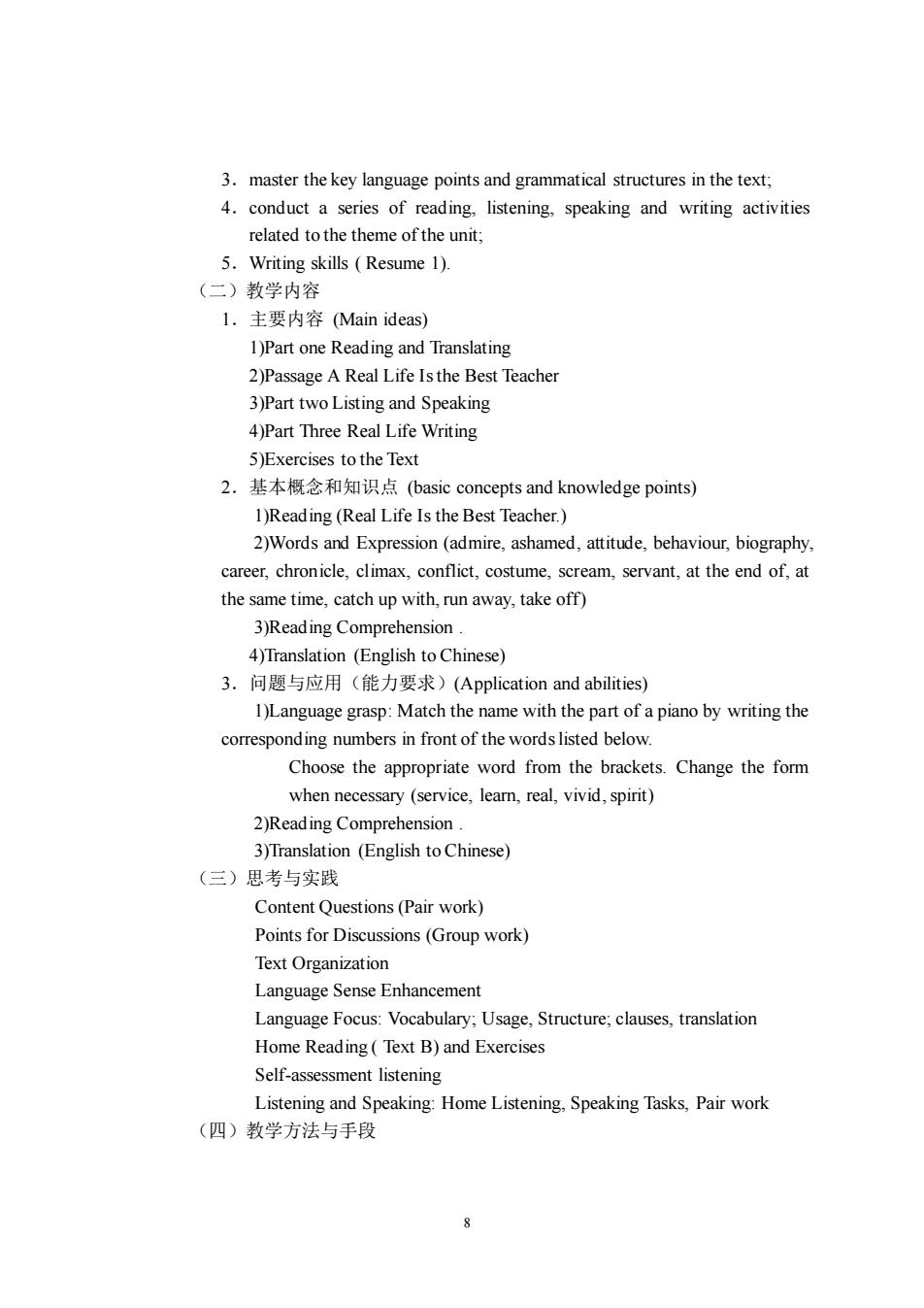
3.master the key language points and grammatical structures in the text; 4.conduct a series of reading,listening,speaking and writing activities related to the theme of the unit 5.Writing skills (Resume 1). (二)教学内容 1.主要内容(Main ideas) 1)Part one Reading and Translating 2)Passage A Real Life Is the Best Teacher 3)Part two Listing and Speaking 4)Part Three Real Life Writing 5)Exercises to the Text 2.基本概念和知识点(basic concepts and knowledge points) 1)Reading(Real Life Is the Best Teacher.) 2)Words and Expression (admire.ashamed,attitude,behaviour,biography. career,chronicle,climax,conflict,costume,scream,servant,at the end of,at the same time,catch up with,run away,take off) 3)Reading Comprehension 4)Translation (English to Chinese) 3. 问题与应用(能力要求)(Application and abilities) 1)Language grasp:Match the name with the part of a piano by writing the corresponding numbers in front of the words listed below Choose the appropriate word from the brackets.Change the form when necessary (service,leamn,real,vivid,spirit) 2)Reading Comprehension. 3)Translation(English to Chinese) (三)思考与实践 Content Questions(Pair work) Points for Discussions(Group work) Text Organization Language Sense Enhancement Language Focus:Vocabulary:Usage,Structure:clauses,translation Home Reading(Text B)and Exercises Self-assessment listening Listening and Speaking:Home Listening.Speaking Tasks,Pair work (四)教学方法与手段
8 3.master the key language points and grammatical structures in the text; 4.conduct a series of reading, listening, speaking and writing activities related to the theme of the unit; 5.Writing skills ( Resume 1). (二)教学内容 1.主要内容 (Main ideas) 1)Part one Reading and Translating 2)Passage A Real Life Is the Best Teacher 3)Part two Listing and Speaking 4)Part Three Real Life Writing 5)Exercises to the Text 2.基本概念和知识点 (basic concepts and knowledge points) 1)Reading (Real Life Is the Best Teacher.) 2)Words and Expression (admire, ashamed, attitude, behaviour, biography, career, chronicle, climax, conflict, costume, scream, servant, at the end of, at the same time, catch up with, run away, take off) 3)Reading Comprehension . 4)Translation (English to Chinese) 3.问题与应用(能力要求)(Application and abilities) 1)Language grasp: Match the name with the part of a piano by writing the corresponding numbers in front of the words listed below. Choose the appropriate word from the brackets. Change the form when necessary (service, learn, real, vivid, spirit) 2)Reading Comprehension . 3)Translation (English to Chinese) (三)思考与实践 Content Questions (Pair work) Points for Discussions (Group work) Text Organization Language Sense Enhancement Language Focus: Vocabulary; Usage, Structure; clauses, translation Home Reading ( Text B) and Exercises Self-assessment listening Listening and Speaking: Home Listening, Speaking Tasks, Pair work (四)教学方法与手段

课堂讲授,课堂讨论,多媒体,网络学习,自主学习 第六单元Animation (一)目的与要求 Students should be able to: 1.grasp the main idea (Traditional and Computer Animation)and the structure of the text. 2.appreciate the narrative skills demonstrated in the text; 3.master the key language points and grammatical structures in the text; 4.conduct a series of reading.listening.speaking and writing activities related to the theme of the unit; 5.Writing skills (Business Card) (二)教学内容 l.主要内容(Main ideas) 1)Part one Reading and Translating 2)Passage ATraditional and Computer Animation 3)Part two Listing and Speaking 4)Part Three Real Life Writing 5)Exercises to the Text 2.基本概念和知识点(basic concepts and knowledge points 1)Reading(Traditional and Computer Animation) 2)Words and Expression (file command use program line display set key list press with format change) 3)Reading Comprehension 4)Translation (English to Chinese) 3.问题与应用(能力要求)(Application and abilities) 1)Language grasp:Match the name with the part of a piano by writing the corresponding numbers in front of the words listed below. Choose the appropriate word from the brackets.Change the form when necessary (frame,animator,lighting,animation,generate) 2)Reading Comprehension 3)Translation (English to Chinese) (三)思考与实践 Content Questions(Pair work) 9
9 课堂讲授,课堂讨论,多媒体,网络学习,自主学习 第六单元 Animation (一)目的与要求 Students should be able to: 1.grasp the main idea (Traditional and Computer Animation) and the structure of the text; 2.appreciate the narrative skills demonstrated in the text; 3.master the key language points and grammatical structures in the text; 4.conduct a series of reading, listening, speaking and writing activities related to the theme of the unit; 5.Writing skills (Business Card) (二)教学内容 1.主要内容 (Main ideas) 1)Part one Reading and Translating 2)Passage A Traditional and Computer Animation 3)Part two Listing and Speaking 4)Part Three Real Life Writing 5)Exercises to the Text 2.基本概念和知识点 (basic concepts and knowledge points) 1)Reading (Traditional and Computer Animation) 2)Words and Expression (file command use program line display set key list press with format change) 3)Reading Comprehension . 4)Translation (English to Chinese) 3.问题与应用(能力要求)(Application and abilities) 1)Language grasp: Match the name with the part of a piano by writing the corresponding numbers in front of the words listed below. Choose the appropriate word from the brackets. Change the form when necessary (frame, animator, lighting, animation, generate) 2)Reading Comprehension . 3)Translation (English to Chinese) (三)思考与实践 Content Questions (Pair work)
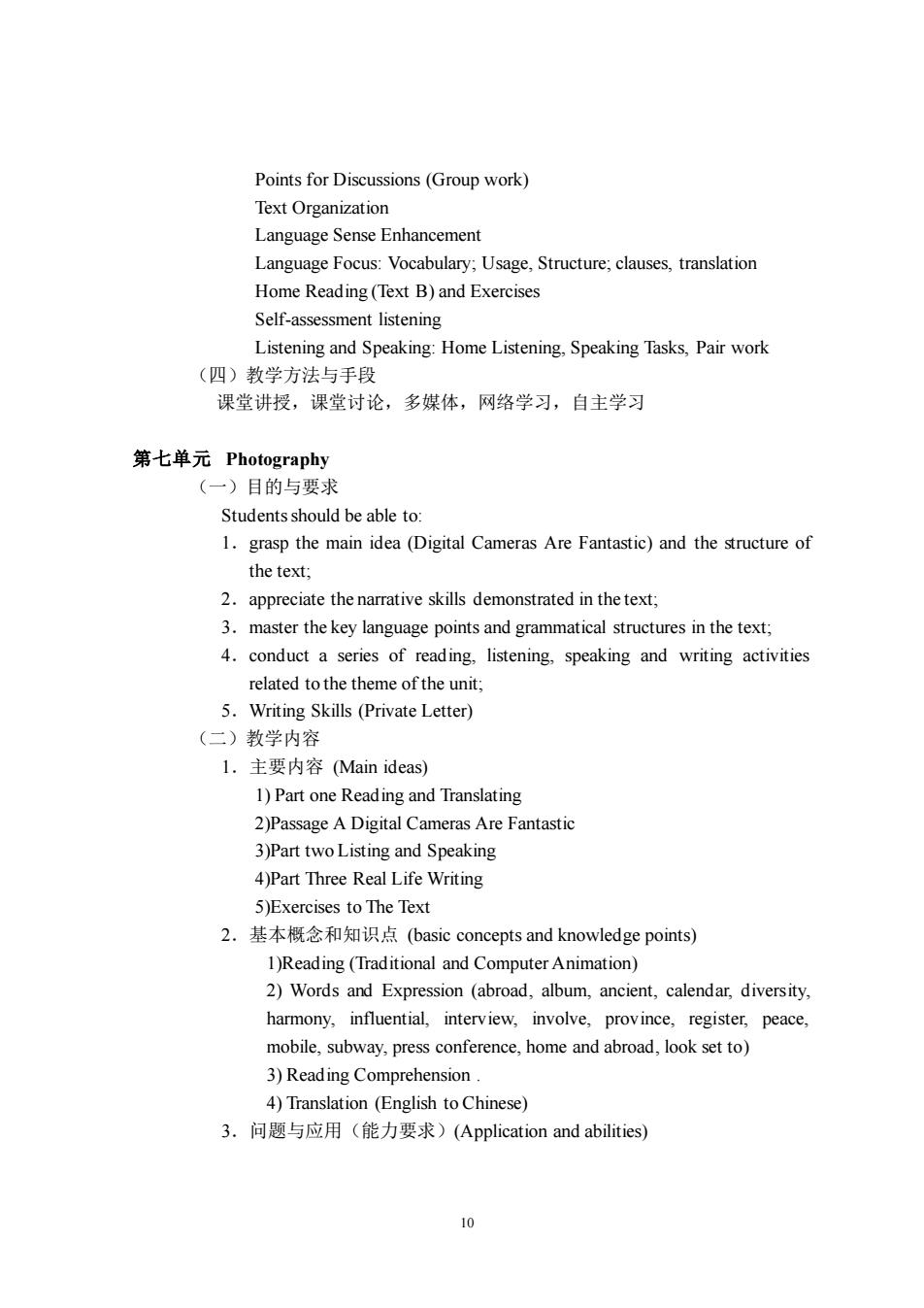
Points for Discussions(Group work) Text Organization Language Sense Enhancement Language Focus:Vocabulary;Usage,Structure;clauses,translation Home Reading (Text B)and Exercises Self-assessment listening Listening and Speaking:Home Listening.Speaking Tasks,Pair work (四)教学方法与手段 课堂讲授,课堂讨论,多媒体,网络学习,自主学习 第七单元Photograph (一)目的与要求 Students should be able to 1.grasp the main idea (Digital Cameras Are Fantastic)and the structure of the text; 2.appreciate the narrative skills demonstrated in the text; 3.master the key language points and grammatical structures in the text: 4.conduct a series of reading,listening,speaking and writing activities related to the theme of the uni 5.Writing Skills(Private Letter) (二)教学内容 1.主要内容(Main ideas)) 1)Part one Reading and Translating 2)Passage A Digital Cameras Are Fantastic 3)Part two Listing and Speaking 4)Part Three Real Life Writing 5)Exercises to The Text 2.基本概念和知识点(basic concepts and knowledge points) 1)Reading (Traditional and Computer Animation) 2)Words and Expression (abroad,album,ancient,calendar,diversity harmony,influential,interview,involve,province,register,peace. mobile,subway.press conference,home and abroad,look set to) 3)Reading Comprehension. 4)Translation (English to Chinese) 3.问题与应用(能力要求)(Application and abilities) 10
10 Points for Discussions (Group work) Text Organization Language Sense Enhancement Language Focus: Vocabulary; Usage, Structure; clauses, translation Home Reading (Text B) and Exercises Self-assessment listening Listening and Speaking: Home Listening, Speaking Tasks, Pair work (四)教学方法与手段 课堂讲授,课堂讨论,多媒体,网络学习,自主学习 第七单元 Photography (一)目的与要求 Students should be able to: 1.grasp the main idea (Digital Cameras Are Fantastic) and the structure of the text; 2.appreciate the narrative skills demonstrated in the text; 3.master the key language points and grammatical structures in the text; 4.conduct a series of reading, listening, speaking and writing activities related to the theme of the unit; 5.Writing Skills (Private Letter) (二)教学内容 1.主要内容 (Main ideas) 1) Part one Reading and Translating 2)Passage A Digital Cameras Are Fantastic 3)Part two Listing and Speaking 4)Part Three Real Life Writing 5)Exercises to The Text 2.基本概念和知识点 (basic concepts and knowledge points) 1)Reading (Traditional and Computer Animation) 2) Words and Expression (abroad, album, ancient, calendar, diversity, harmony, influential, interview, involve, province, register, peace, mobile, subway, press conference, home and abroad, look set to) 3) Reading Comprehension . 4) Translation (English to Chinese) 3.问题与应用(能力要求)(Application and abilities)